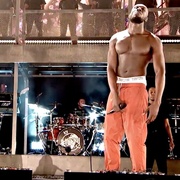New York, NY (Top40 Charts) Understanding, a blazing 1970 concert recording featuring the Detroit-born master percussionist Roy Brooks leading a gifted quintet through its spirited paces at Baltimore's Famous Ballroom, will be released by Reel to Real Recordings in June.
Comprising more than two hours of expansive performances averaging 20 minutes in length, the potent date was recorded by Left Bank Jazz Society and stars trumpeter Woody Shaw, tenor saxophonist
Carlos Garnett, pianist Harold Mabern, and bassist Cecil McBee. It will initially be issued on July 17, 2021 as a three-LP set mastered by
Kevin Gray at Cohearent Audio and pressed on 180-gram platters at Standard Vinyl in Toronto. The set will be released as a two-CD set and digitally on July 23, 2021.
All proceeds from the release - produced with the cooperation of McBee and Garnett and the estates of Brooks, Mabern, and Shaw - will go directly to the
Detroit Sound Conservancy, a non-profit organization founded in 2012 and devoted to the preservation, education, conservation, and placekeeping of the Motor City's musical heritage.
In a statement included in the release, label co-founders Zev Feldman and Cory Weeds and partner Raymon Torchinsky say, "Inspired by Roy Brooks' music and the message of the
Black Lives Matter movement, we have produced Understanding as our celebration of the talent, courage, spirit and resilience of the
Black musicians and musicians of color who created a timeless and universal art. We recognize and acknowledge that the injustices of fifty years ago are still with us; it is time for change."
The collection is the third archival treasure from Reel To Real from the Left Bank - which mounted live jazz shows in Baltimore from 1964 through the '90s - to be unearthed by Resonance Records co-president and noted "Jazz Detective" Feldman, who is partnered in Reel to Real with Vancouver-based jazz impresario and saxophonist Weeds.
Last November, Reel to Real issued The
George Coleman Quintet in Baltimore - a widely praised collection drawn from a 1971 stand at the Famous Ballroom by the tenor saxophonist's band - as a
Black Friday Record Store Day exclusive title. Reel To Real had previously released A Soulful Sunday by vocalist Etta Jones featuring the Cedar Walton Trio.
Born in 1938, Roy Brooks is perhaps best known as a sideman. He spent five years with pianist Horace Silver's storied hard bop combo, appearing on the popular Song for My Father, and also worked behind Chet Baker, Yusef Lateef, and Charles Mingus, and alongside Max Roach in the percussion ensemble M'Boom.
Beyond his formidable, gale-force attack on the traps, Brooks - who died in his hometown in 2005 - delighted audiences with flights on the musical saw (heard on the present recording) and even invented a device, the "breath-a-tone," with which he could change the pitch of his drums as he played. Sadly, the musician's career was thrown off track in later years by severe mental illness. But the Famous Ballroom date displays him at the height of his considerable powers.
In his comprehensive liner notes for the collection, historian Mark Stryker, author of Jazz from
Detroit (University of Michigan Press, 2019), writes that Understanding "shines a long-overdue spotlight on Brooks. A product of Detroit's mid-century jazz explosion, Brooks was a deeply swinging drummer of uncommon creativity, flexibility, fire and conceptual imagination."
Led off by a 42-minute performance encompassing the Brooks-composed prelude and title track, Understanding roars through compositions by Shaw ("Zoltan," first heard on organist Larry Young's 1965 classic Unity) and Garnett ("Taurus Woman") and a furious take on Charlie Parker's "Billie's Bounce" before an involved, vocal audience. Projected at a fever pitch, the music operates on the cusp between the '60s quintet innovations of Miles Davis (whose "
The Theme" closes the gig) and the free-form explorations of
John Coltrane and his acolytes.
Understanding is filled out by intimate written remembrances by a pair of Brooks' classmates at Detroit's Northwestern High School, journalist Herb Boyd and alto saxophonist Charles McPherson.
Boyd writes, "There was no limit to Roy's imagination, which extended to making music while dribbling a basketball, breathing air through tubes attached to his drums to modulate the tones, and applying his mallet to a bending carpenter's saw and turning it into a vibrating thing of beauty."
"He definitely had a concept of percussion and how to be musical," McPherson adds. "So he's not just some guy playing the drums; he actually knows when to be soft, when to be loud, when to be busy, when not to be busy. He naturally had that. So he was an interesting player, and he had his own style."
Another
Detroit contemporary, Louis Hayes, recalls how Brooks ended up succeeding him in Silver's group: "I told Horace, 'Roy Brooks, in
Detroit - he can handle it.' So Horace got Roy Brooks. That's how Roy came to New York in '59."
In an interview with Weeds, bassist Cecil McBee - who also worked with Brooks on another celebrated live album led by the drummer, the 1972 Muse release The Free Slave - offers a close-up view of the musicians in Brooks' combo and the jubilation of playing at the Famous Ballroom.
"The experience at the Famous Ballroom is far beyond the excitement that I would find if I played somewhere in New York," McBee says. "Really great."
Another of Brooks' rhythm section partners, the legendary bassist Reggie Workman, notes in an interview with Feldman, "Roy was always a very serious, creative, steadfast person. Great sense of humor. Lots of energy, and very definite about what he wanted to do in the music and how it related to our culture. And he was always interested in doing things that related to unity and the evolution of our music and culture. That's how I remember Roy: a giving person, a creative person."
Feldman says of Reel to Real's latest exciting historic discovery, "Roy Brooks was a revolutionary, and these recordings celebrate his genius. They also celebrate the musicians on the recording and the time this music was made. This is some of the most burning and inspiring music I've heard, and these guys are giving everything they've got."
Weeds adds, "The thing about this music that I love the most is that the sheer passion and intensity jump out of the speakers and grab you."
























